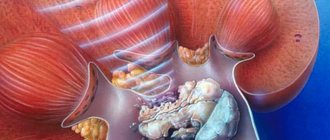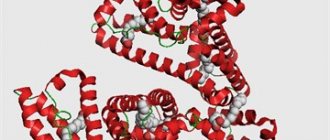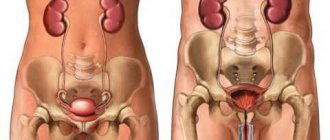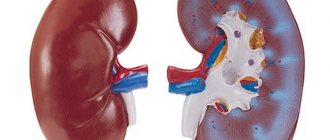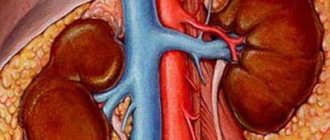How does diabetes affect the kidneys?
Diabetes mellitus is considered a dangerous disease that can cause complications in various organs. In particular, diabetes and kidneys are closely related. The internal organ has important tasks: it cleanses the plasma, while all nutrients are returned back into the bloodstream. The waste in turn is sent to the bladder and exits the body. If the kidneys are functioning normally, then health will be good.
In type 1 diabetes, kidney deformation occurs. There is a thickening of the walls of the internal organ, as well as the surfaces adjacent to it. Because of this, the number of capillaries decreases, and the organ itself begins to remove less fluid over time. The purified blood volume gradually begins to decrease, but the symptoms of the pathology do not immediately become noticeable.
Often, kidney disease remains chronic for a long time, and people are not even aware of its presence. At the same time, alarming signs begin to arise when even additional glomeruli can no longer perform all the functions of the organ. It is worth noting that in some people the pathology quickly becomes acute. As a result, because of this, the condition of the kidneys is significantly impaired, and other organs also suffer. That is why it is important to know the alarming symptoms of the disease, so that later you do not have to face a sharp deterioration in your health. Also, the right decision would be to take a blood test in order to assess the functionality of the kidneys.
Treatment in the initial stages
In order to prescribe treatment, it is necessary to conduct a complete diagnosis of the whole organism. The selection of drugs and methods of treating kidney disease for each person is strictly individual.
To completely cure diabetic nephropathy, it is important to start doing this on time. The microalbuminuria stage is the only one at which reversible processes occur.
To treat kidney disease, it is important to follow the prescriptions and recommendations of your doctor:
- following a low-calorie diet;
- taking medications to lower blood pressure;
- diuretics;
- food without salt.
When treating this stage, you need to monitor the level of glycosylated hemoglobin and constantly monitor carbohydrate and fat metabolism in the body. This is done with the help of diets and medications that regulate these processes.
It is imperative to take medications that reduce blood pressure, even if it is normal, the minimum dose must be present daily. This is necessary to reduce the level of albumin in the urine and prevent changes in the kidney structure.
When the stage of proteinuria sets in and hypertension occurs, you need to limit the consumption of salt and canned foods. You need to cook the food yourself and do not add salt; lemon juice, pepper and herbs are used to add flavoring effects.
It is imperative to limit the consumption of carbohydrates and fats, and at this stage the choice of drugs to lower blood sugar is narrowed, because there is a risk of toxic damage to the kidneys. If the drugs cease to be effective, then it is recommended to start insulin therapy.
At this stage, arterial hypertension often develops and salt restriction helps it not to rise to high levels, but if this happens, the necessary medical substances are prescribed to normalize it.
Often this is not enough and a treatment regimen with two drugs is used, which leads to the following results:
- increased hypotensive effect;
- removing side effects of drugs.
Medicines must complement each other’s actions, and they must be selected by a doctor, taking into account all contraindications in the body of a sick person. It is important to control not only blood pressure, but also the amount of fluid you drink. For edema, diuretics are taken.
boleznikrovi.com
Causes of kidney disease in diabetes
Some people don't even think about the fact that they themselves are causing kidney disease. Of course, the main cause of the disease is a large amount of sugar in the bloodstream. At the same time, other factors that occur quite often also have an influence.
Possible reasons:
- Abuse of fast food. In this case, you should not be surprised that your health has deteriorated significantly. Fast food always harms the body, while there is nothing useful in it. If a person is inclined to eat hot dogs, hamburgers, French fries and similar products, then kidney pathologies will not take long to appear.
- Bad heredity. When close relatives suffer from kidney pathologies, the person is also likely to encounter them. For this reason, it is especially important for risk groups to monitor their diet and lifestyle. It becomes mandatory to give up fast food, otherwise deterioration in health will lead to complications.
- High blood pressure. It is often observed in the presence of diabetes mellitus. For this reason, it is extremely important to ensure that your blood pressure remains within normal limits. Due to its surges, the entire body will suffer, including the kidneys. It is worthwhile to prevent this problem, and also take care to normalize high blood pressure in time.
It should be noted that there are two forms of diabetes. In the first case, the disease is caused by a glucose transport disorder. A similar situation arises if the functionality of the membrane carrier, as well as the membranes themselves, deteriorates. In addition, a deviation can develop due to dysfunction of the transport system and a decrease in the mass of the tubules.
Renal diabetes also includes another form - saline diabetes. It has nothing to do with the sugar look. This pathology develops due to tuberculosis, brain injuries, problems with the hypothalamus and autoimmune diseases. In any case, it is not allowed to leave alarming symptoms unattended, because kidneys and diabetes are closely interrelated.
Diagnostic and treatment methods
Among the diagnostic methods, the following laboratory and instrumental studies can be used:
- general urine test - for urine concentration, for the presence of glucose and ketone bodies;
- blood biochemistry - the level of potassium, sodium, glucose, urea and creatinine;
- urine test against the background of dehydration;
- ultrasound examination of the kidneys - you can detect inflammatory processes in the kidneys and changes in the size of the pelvis, ureters and bladder;
- magnetic resonance imaging of the brain;
- in difficult cases, a kidney biopsy is performed.
Urine testing for sugar content is carried out from a portion of urine taken from the total volume of urine collected per day.
If, according to the results of studies, the excretion of glucose in the urine is more than 2 g and changes in the structure of the kidneys are detected, then renal diabetes mellitus is diagnosed.
Renal salt diabetes is confirmed if a sodium deficiency is detected in the body and an excess of electrolyte in the urine
Based on the test results against the background of dehydration, namely, if there is a 5% decrease in the patient’s weight with unchanged urine characteristics, low concentration and relative density of urine, then nephrogenic diabetes insipidus is diagnosed.
Treatment is prescribed depending on the type of pathology. In salt diabetes, the main stage of therapy is to replace lost electrolytes and prevent dehydration. To do this, the patient is given an intravenous infusion of saline solution.
An important addition will be a diet with limited protein intake and dosed consumption of fats and carbohydrates.
More plant foods, juices, compotes and clean water are introduced into the diet. Products such as salt, coffee, soda and alcoholic beverages are excluded.
Diabetes insipidus is treated with diuretics and non-steroidal anti-inflammatory drugs (Indomethacin, Ibuprofen).
Hormonal agents (Minirin, Desmopressin) may also be prescribed. If the disease is caused by the presence of a tumor in the hypothalamus, then the question of the possibility of surgical intervention is decided.
Renal diabetes mellitus does not require special treatment. The patient is prescribed intravenous infusions of saline solutions to prevent dehydration, a diet with limited sugar intake, and regular monitoring of glucose levels.
Symptoms of pathology development
If a person has impaired kidney function, then one may encounter alarming signs. If they occur, you should immediately go to a medical specialist.
Characteristic symptoms:
- High blood pressure that is difficult to stabilize.
- Swelling, affecting not only the legs, but also the face, as well as the upper limbs. This phenomenon is observed both during the day and at night.
- Painful sensations in the lumbar and chest areas.
- Pink tint of urine. In advanced cases, it may turn red.
- Constant skin itching. In this case, there is no rash on the body.
- Frequent urination. During this process, a person often feels a burning sensation and severe itching.
Every person can notice these symptoms when kidney failure occurs due to diabetes. If at least a few of these signs appear, it is important to get tested. Already from them it will be possible to accurately judge whether there is a problem with the organ.
Clinical symptoms of the disease include the following:
- The presence of protein in urine.
- Changes in leukocyte counts in urine.
- Red blood cells. The doctor will pay special attention to them during diagnosis.
Of course, you should not fight pathology on your own, as this will not bring the desired results. It is imperative to consult a doctor so that he can make an accurate diagnosis. In addition, the doctor must prescribe a specific treatment regimen that will help overcome the disease.
Causes of kidney diabetes
There are several forms of renal diabetes:
- Saline - occurs due to the loss of renal tubules' susceptibility to aldosterone, a hormone synthesized by the adrenal glands. As a result, the process of sodium reabsorption is disrupted, and it is excreted in excess from the body in the urine.
- Glucosuria (sugar) - develops when renal function is impaired and is determined by the appearance of glucose in the urine, against the background of acceptable blood sugar levels.
- Nephrogenic insipidus - in this case, the sensitivity of the renal glomeruli to the hormone secreted by the pituitary gland decreases. With this pathology, an increased volume of low-concentrated urine is released.
Factors that provoke the development of salt diabetes are:
- traumatic brain injuries;
- vascular diseases;
- genetic predisposition;
- infectious diseases;
- autoimmune pathologies;
- oncological brain tumors;
- pathologies of the pituitary gland and hypothalamus.
Renal diabetes mellitus can be congenital (primary) or develop as a result of chronic renal pathologies (secondary).
Glucosuria is often diagnosed in pregnant women and can be pathological and physiological.
Pathological glycosuria occurs for the following reasons:
- fetal abnormalities or high weight;
- hereditary factor;
- severe poisoning;
- acute pancreatitis;
- pregnancy after 35 years.
The physiological type of the disease develops under the following factors:
- hormonal disorders;
- high rate of blood filtration in the kidneys and increased blood flow;
- decreased permeability of cell membranes.
If glucose is detected in the urine, the test is repeated, since this indicator does not always indicate the development of a pathological process in the kidneys.
Sugar in the urine can appear as a result of overindulging in sweets before the test day or after physical fatigue.
Usually in such cases, in the results of a re-analysis, all indicators return to normal. If glucose is again detected in urine, then a comprehensive examination is prescribed.
Diagnosis of the disease
When a person goes to the hospital complaining of symptoms of kidney diabetes, the doctor will refer the person for specific tests. Based on their results, it will be possible to clearly judge the patient’s condition. First of all, a person will be sent for urine analysis, because its composition can be used to judge the presence or absence of a disease. You will also need to perform an ultrasound of the kidneys; it is recommended if there are stones in this organ. Also, during such a study, cysts can be diagnosed.
A medical specialist will prescribe an excretory urography. Using an x-ray using a contrast agent, it will be possible to generally assess the size of the organ, as well as its location. In addition, it will be possible to understand the condition of the urinary tract.
A puncture biopsy of the kidneys is required. To do this, a certain part of the organ will be taken, which will be examined for the presence of abnormalities. If they are detected, then we can clearly judge the presence of the disease.
Computed tomography is also recommended if kidney problems occur. From it it will be possible to clearly understand the condition of the vessels. Also, if present, it will be possible to identify stones and neoplasms that are present in the body.
Salt therapy for diabetes
Treatment of renal glycosuria is aimed, first of all, at eliminating the symptoms accompanying the disease, mainly at normalizing the water-salt balance. For this purpose, patients are given IVs with saline solution. The prognosis for early treatment of the pathology is completely favorable.
When treating sodium renal diabetes, the water-salt balance is usually normalized. However, in parallel with the saline solution, a sodium solution and, in some cases, an antidiuretic hormone are administered.
In cases where the pathology is viral or bacterial in nature, antibiotics or antiviral agents are prescribed. Anti-inflammatory drugs may be prescribed along with them.
In addition, patients suffering from a lack of antidiuretic hormone in the body are recommended a special diet that involves frequent meals in small portions (the person should eat enough, but not overeat) and an increase in the volume of complex carbohydrates in the diet.
- Glucose in urine during pregnancy: causes, norm
In this case, the menu is diversified by introducing products based on cereals, cereals and legumes, excluding protein-containing products, salt, alcohol, sweet carbonated water and coffee (this will help reduce the load on the kidneys).
You should quench your thirst with fruit drinks, homemade compotes, and green tea. In consultation with your doctor, you can use folk remedies.
Such changes in the diet contribute to the restoration of impaired metabolic processes in the body and, accordingly, a speedy recovery.
When renal diabetes is a consequence of brain tumors, patients are operated on if possible, and if it develops against the background of a traumatic brain injury, therapy is prescribed aimed at eliminating its consequences.
Treatment of the disease should occur under the supervision of a specialized specialist. Self-medication in this case is not only unacceptable, but can also lead to the most disastrous consequences.
Classification
There are two types of salt diabetes:
- Primary is a congenital disease that manifests itself as a result of genetic predisposition and occurs as a result of impaired reabsorption of glucose in the renal tubules. Diagnosed in infants.
- Secondary - manifests itself against the background of the following diseases: nephritis, nephrosis, diabetes mellitus, renal failure. May occur as a result of intoxication.
Stages of the disease
Diabetic nephropathy is a term that unites a whole group of different kidney problems. Diabetic nephropathy is a term that unites a whole group of different kidney problems, the essence of which boils down to damage to the blood vessels of the organ due to the chronic course of diabetes.
The following diseases are usually classified as diabetic nephropathy:
- atherosclerosis of the renal artery;
- diabetic glomerulosclerosis;
- pyelonephritis;
- the presence of fatty deposits in the renal tubules;
- necrosis of kidney tubules and other pathologies.
Diabetic nephropathy is often called Kimmelstiel-Wilson syndrome, according to one of the types of glomerulosclerosis. Moreover, nephropathy due to diabetes and diabetic glomerulosclerosis are very often used as synonyms in medical practice.
Typically, various disorders of the kidneys are recorded in insulin-dependent diabetes, that is, in type 1. This disease affects almost half of patients with diabetes of this type and is the main cause of death among diabetics. In patients with type 2 diabetes, such problems are recorded only in 16-31% of cases.
If a patient develops diabetic nephropathy, the stages of the disease can be determined according to the classification generally accepted in 1983
If a patient develops diabetic nephropathy, the stages of the disease can be determined according to the classification generally accepted in 1983:
- Stage 1 develops at the very beginning of the disease and is characterized by hyperfiltration and hyperfunction of the kidneys. It is very difficult to clinically determine this stage, since the block is not detected in the urine and there are no external signs. The cells of the renal vessels are slightly enlarged.
- Stage 2 is characterized by microalbuminuria and thickening of the walls of the renal vessels. This stage develops after 2-4 years. The first structural changes occur in the organ, but protein may still not be detected in the urine, and the excretory function of the organ is normal.
- Stage 3 is incipient nephropathy. This stage is characterized by proteinuria. It develops after 5 years. The main signs of diabetic nephropathy at this stage are microalbuminuria, protein in the urine. The filtering capacity of the organ is reduced due to damage to the renal vessels. At this stage, problems with blood pressure appear. All characteristic symptoms appear due to a decrease in the filtering capacity of the glomeruli of the kidneys. At this stage, changes in the organ are still reversible, but diagnosing the disease is difficult, since the patient does not feel any significant health problems. The disease can only be diagnosed using laboratory methods or a kidney biopsy.
- Stage 4 of the disease is characterized by severe nephropathy, as well as the presence of nephrotic syndrome. This stage develops 10-14 years after the onset of diabetes. Renal sclerosis affects 50 to 75% of the glomeruli. The main manifestations of the disease are as follows:
- heartache;
- dyspnea;
- proteinuria;
- decreased protein in the blood;
- headache;
- strong thirst;
- increased blood pressure;
- multiple edema;
- drowsiness;
- decreased appetite;
- weakness;
- nausea.
- Stage 5 is characterized by the development of renal failure. In other words, complete glomerulosclerosis occurs. This usually occurs 15-25 years after the onset of diabetes. As a result, the parenchyma of the organ is replaced by dense connective tissue, that is, complete vascular sclerosis occurs. The glomerular filtration rate decreases to critical levels, therefore, practically no purification of blood and urine occurs. If urgent measures are not taken, the person may die.
The diagnosis of diabetic nephropathy indicates damage to the filtering elements in the kidneys (glomeruli, tubules, arteries, arterioles) as a result of a malfunction in the metabolism of carbohydrates and lipids.
The main reason for the development of nephropathy in diabetics is an increase in blood glucose levels.
At an early stage, the patient develops dryness, an unpleasant taste in the mouth, general weakness and decreased appetite.
Symptoms also include an increase in the amount of urine produced and a frequent urge to urinate at night.
Nephropathy is also indicated by changes in clinical tests: a decrease in the level of hemoglobin, specific gravity of urine, an increased level of creatinine, etc. At more advanced stages, disturbances in the functioning of the gastrointestinal tract, itching, swelling and hypertension are added to the above symptoms.
Important!
If a patient is diagnosed with diabetes, it is necessary to take a blood test for creatinine (with calculation of glomerular filtration rate) and a general urine test at least once a year to monitor the condition of the kidneys!
Cystitis in diabetes
Cystitis is, unfortunately, a common phenomenon.
Many people know it as an inflammation of the bladder of an infectious nature.
However, few people know that diabetes mellitus is a risk factor for this pathology.
This circumstance is explained:
- atherosclerotic lesions of large and small vessels;
- disruptions in the immune system, which significantly reduce the protective capabilities of the bladder mucosa. The organ becomes vulnerable to the effects of pathogenic flora.
The appearance of cystitis cannot be ignored. He makes himself known:
- problems with urine output. The process becomes difficult and painful;
- pain in the lower abdomen, reminiscent of contractions. They cause the greatest suffering when trying to urinate;
- blood in urine;
- signs of intoxication, one of which is an increase in body temperature against a background of general malaise.
In the absence of medical intervention, the condition rapidly progresses, developing complications, and may require hospitalization.
